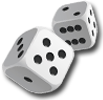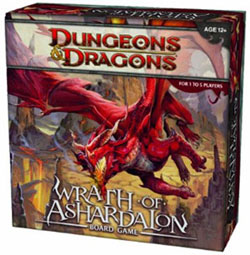



play board games
Board game reviews, strategy tips & session reports
Wrath of Ashardalon Review
 Stats:
Stats:
No. of players: 1-5
Amount of time to play: 60 min
Age requirements: 12+
Set-up time: 10-15 min
Wrath of Ashardalon Rules Description:
Wrath of Ashardalon is a cooperative Dungeons and Dragons board game. You delve into dungeons with goals based on the different adventures. Can you survive til the end of this dungeon crawl?
Setup is different for each adventure but involves each player choosing an hero, shuffling and placing dungeon tiles and setting up the monster, encounter and treasure decks. After selecting a hero you should choose your at-will and daily powers. These are the powers and attacks you’ll use against the monsters in the dungeon.
On your turn there are three phases, the Hero Phase, Exploration Phase and Villain Phase. You might have guessed this but the Hero Phase is when you activate your hero. Each hero phase, you may either move and then attack, attack and then move or move twice. Each hero has a move speed and that is the number of squares you may move.
When you attack you choose which of your powers you’d like to use. If attacking at a range the range is counted by tiles. You may not count tiles diagonally. Using a daily or utility power will cause you to flip it over. There are some instances in which these powers are restored, but for the most part they may be used once per game. At-will powers may be used as often as you like.
Each power lists the attack bonus and the damage. In order to hit a monster you roll the d20 and add the attack bonus. If your total is equal to or greater than the monster’s armor class (AC), you hit. Monsters that are killed go into a group experience pile and you get to take one treasure card. There is a limit of one treasure card per turn so even if you kill three monsters on your turn you will still only get one treasure card.
During the Exploration Phase if you are on an unexplored edge of a tile, you flip over the next tile and place it with arrow pointing toward the tile you are currently on. This will also spawn a new monster. A new monster card is drawn from the top of the monster deck. You then place the miniature of the selected monster on the scorch mark of the new tile.
At the beginning of the Villain phase if you have not explored a new tile or if you drew a tile with a black arrow, you must draw an encounter card. Encounter cards represent random events happening inside the dungeon. Most are bad like, traps, attacks and alarms, while some will help you.
Again this may be obvious but during the Villain Phase you activate the monsters. Monsters only activate on the player’s turn that drew them. If there is more than one monster in play with the same name those monsters will activate each time someone with one of their cards takes a turn.
Monsters follow some basic tactics depending on how close they are to a hero. Some make ranged attacks and others only attack if adjacent to a hero. If too far away many monsters will move. Monsters move from tile to tile (not square to square) via the scorch marks. If a scorch mark you are moving the monster to is occupied, you may place the monster to any square in that tile.
After the Villain Phase is over, the next player starts their Hero Phase.
A couple sidebars first you can use monsters in the experience pile in one of two ways. The first is level up your hero. If you roll a 20 during an attack or when attempting to disable a trap, you may discard five experience points worth of monsters to flip your hero card over. The other side is your hero at second level. You get more hit points, a higher AC and another daily power.
You may also spend five experience points worth of monsters to cancel an encounter card you just drew.
Whenever you spend experience points you may not make change so if you only have two monsters in the experience pile worth three experience points each, you’ll just have to discard them and overspend a bit.
If your hero is ever brought to zero hit points, at the start of your Hero Phase you may use a healing surge. Healing surges heal half your hero’s total hit points. Each adventure starts the players with two or more healing surges. If at anytime a hero tries to use a healing surge and there are none left, the game is over and the players have lost.
A Quick Review of Wrath of Ashardalon:
Wrath of Ashardalon will be very familiar if you have played Dungeon and Dragons Fourth Edition. Even having played an older edition of DnD will help you understand the basic mechanics of Wrath of Ashardalon. My wife tried it with me and said, “This is just like DnD”. That said the rules are well-written and straight-forward enough that anyone can learn this game pretty quickly.
This game comes in a big box full of high quality components. Some people might be upset the figures aren’t painted. But you get a lot of them and they look great. The artwork on the box and cards is great and as you would expect fit the dungeon delving theme perfectly.
There are many good things to say about this game, but I am going to highlight a few things that stood out to me. I really enjoy the fact that Wrath of Ashardalon can be played solo and still be challenging without being overwhelming. Many solo games have trouble with that balance.
Wrath of Ashardalon is also great for game groups that enjoy RPGs, but either don’t have a Dungeon Master or don’t want to invest the time in a full-blown RPG. It even has rules for a campaign mode that can help bridge that gap.
There is some good tension in the game. You want to avoid encounter cards by exploring, but that puts more monsters on the board. You often have to pick the lesser of two evils and hope for the best.
The pacing in Wrath of Ashardalon can be a little monotonous. You might wait for other players to take their turns and then feel like you are doing relatively the same action every turn. This is less pronounced in the solo game as you play all the heroes and have a larger variety of actions to take.
If you enjoy fantasy-themed board games and RPGs or are looking for a dungeon excursion game than you will want to get Wrath of Ashardalon. It is also great for Dungeon Masters looking to get figures and have something to play if not enough players can make it out to roleplay. Like I said above it shines in solo play.
Score and synopsis: (Click here for an explanation of these review categories.)
Strategy 3 out of 6
Luck 4 out of 6
Player Interaction 3 out of 6
Replay Value 4 out of 6
Complexity 4 out of 6
Fun 5 out of 6
Overall 4 out of 6

Hmm, that’s not quite a glowing review. It sounds nice, but for the price tag, I’m not sure it is worthwhile. And I am disappointed the minis aren’t painted, but if they scale to D&D perfectly and include a lot of stuff you are likely to use in a D&D game, I may pick this up. Can you give exact counts on the minis included and the type? I didn’t see anything of that nature on the information when I looked at the game in the store, but maybe I missed it.
There are 42 figures. (I listed the set if known)
3 of each of these:
Blood of Vol Cultist (Blood War)
Cave Bear (Against the Giants)
Duergar Warrior (Archfiends)
Gibbering Mouther (Aberrations)
Grell (Deathknell)
Fiendish Snake (Blood War)
Kobold Champion (Aberrations)
Legion Devil (Savage Encounters)
Orc Mauler (War Drums)
Orc Archer
1 of each of these:
Huge Red Dragon (Giants of Legend #71)
Rage Drake (Desert of Desolation #53)
Gauth (Archfiends #34)
Duergar Captain
Orc Shaman
Otyugh (Giants of Legend #27)
Meepo, Dragonlord (War of the Dragon Queen #06)
1 of each hero:
Human Cleric
Elf Paladin
Half-Orc Rogue
Dwarf Fighter
Dragonborn Wizard
Here is a link to some great photos: http://boardgamegeek.com/thread/621341/detailed-pictures-of-the-minis
Also I do like the game alot. I just tried to write mostly about the things that piqued my interest the most and what I thought made it better than some other dungeon crawls or co-op games. Lastly I am sure you can find this online for less than what the MSRP is.
Thank you for this review. I am considering getting this product and I found your observations helpful. I’m going to buy WOA, and if I like it, I’ll consider getting the others.